Ivan Dibble’s Ameca Project
To protect Ameca splendens in its native habitat
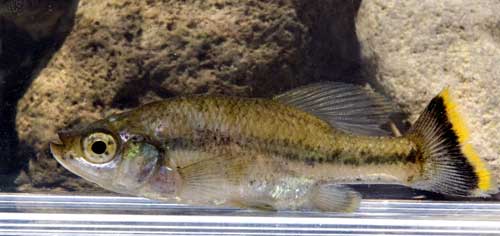 Ameca splendens is the name of a little fish with a bright yellow vertical
stripe on the male’s tail, popular among aquarium owners all around the world.
It is found in the Teuchitlán River, not far from the famous “circular pyramids”
of Teuchitlán in the West Mexico state of Jalisco. Ameca s. gives birth to its
babies live, loves to eat algae and quickly became popular among fish fanciers
when Ivan Dibble of the British Livebearer Association brought the fish to
England and began raising and distributing it to his fellow hobbyists.
Ameca splendens is the name of a little fish with a bright yellow vertical
stripe on the male’s tail, popular among aquarium owners all around the world.
It is found in the Teuchitlán River, not far from the famous “circular pyramids”
of Teuchitlán in the West Mexico state of Jalisco. Ameca s. gives birth to its
babies live, loves to eat algae and quickly became popular among fish fanciers
when Ivan Dibble of the British Livebearer Association brought the fish to
England and began raising and distributing it to his fellow hobbyists.
After several years, Dibble was told that the Amecas had become extinct in their
native habitat, victims of the pollution of so many rivers and lakes in western
Jalisco. Later, however, a small population of them was found in a spring-fed
pool at a restaurant on the shores of badly polluted La Vega Lake. Around that
time, Ivan Dibble had already started his Mexican Fish Ark project
in Morelia,
where colleagues of his were caring for endangered Mexican fish brought to them
from England by Dibble. But upon learning that some Amecas could still be found
in their original habitat, Ivan decided something had to be done to keep this
fish from going extinct.
ORIGIN OF THE AMECA
PROJECT
This is where my wife Susy and I came into the picture. We heard the curious
tale of “an Englishman trying to save Mexico’s fish” from our good friend
biologist José Luis Zavala. We then published an article on this unsung hero and
began corresponding with Ivan Dibble via email. In February of 2008, Ivan gave
us a phone call, urging us to look for a site along the Teuchitlán River where
Ameca splendens might still be surviving, a site where the fish could be
protected.
|
As a result, one day in early 2008, we walked into Balneario El Rincón, a
popular recreational area and the very spot where the Teuchitlán River is born.
We told the manager what we were looking for.
“Oh, sí sí, that cute little fish with the yellow stripe—we have lots of them."
Some of the natural pools at
El Rincón
|
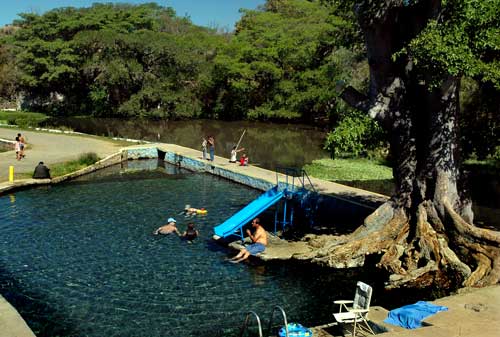 |
We took a look around and found that, sure enough, a small, shallow lake on the
property had plenty of Amecas in it, but also a fair number of bathers. But the
Balneario had other natural pools and one very small one, fed by a spring,
looked to us like the ideal place to create a protected home for Ameca splendens.
We reported back to the manager who told us this Balneario had “an ecological
orientation” and all we had to do was present our project to the Board of
Directors on the second Sunday of the next month.
OH FOR A QUORUM!
So, armed with handouts extolling the virtues of the humble Ameca, we turned up
on the second Sunday only to be told that not enough of the Directors had
appeared for a quorum. Would we mind coming back next week?
| So, we waited a month and the day before the meeting, phoned up the
manager…well, actually we tried to call her but neither the Balneario phone nor
her cell phone happened to be working. Ah, yes, I should remind you all this is
happening in rural Mexico, in case you forgot.
Biologists Sergio Cajiga and
José Luis Zavala at the Balneario |
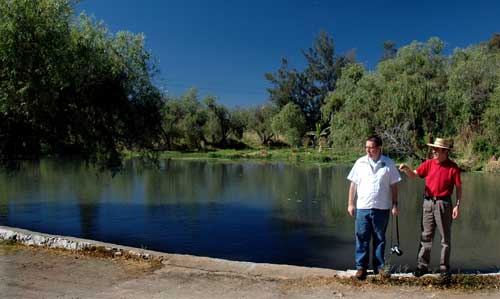 |
“Chin!” (Argh!) we said and the next morning drove all the way to the Balneario,
only to be told that the meeting had again been put off. But this time we asked
a few more questions and discovered that there was a big dispute among the
members of the Mesa Directiva. It seems Doña so-and-so had died and left her
shares to her children and now all of them insisted they be seated at board
meetings, but Señor so-and-so objected to this and…“Well,” said the manager, “It
could take years before this is settled and meanwhile, no decisions can be made
about anything, in fact, the only solution may be to sell the Balneario.”
Well, suddenly El Rincón no longer looked like a long-term safe place to entrust
the survival of any species. “Let’s check out the rest of the river,” I
suggested.
THE
TEUCHITLÁN RIVER
Ivan had told us the river was polluted, but we decided to walk its entire
length (only about one kilometer) to see what we could see.
On June 7, 2008, we parked at the spot where the Teuchitlán River goes under the
highway and pours into La Vega Lake. We had a machete along, figuring we might
have to bushwhack our way along the river bank.
| What a surprise it was to discover a brand-new, wide walkway along the entire
length of the river! It was a combination people-bicycle-and-horse trail,
pleasantly shaded and with occasional benches where one could sit and gaze upon
the absolutely beautiful river.
The Walkway
|
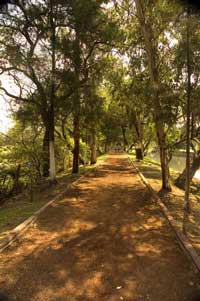 |
Although the view was magnificent, the water quality was anything but. Effluents
pour into the river from a little settlement on one side and several farmers’
fields on the other. We didn’t see a single living fish until we had walked
about 870 meters upstream, within site of the Balneario, at which point, Susy
leaned over the water and shouted “Ameca splendens!”
Knowing that rivers and their banks are government property, we figured this was
the perfect place for a fish lab, forever safe from the wrangling of
stockholders and such.
THE BUBBLING SPRING
A week later we went to see the builder of the walkway, Enrique Meza, Municipal
President of Teuchitlán. He drove us to the riverside, saying, “I’m going to
show you an even better place to find those fish, a perfect spot...”
| ...Sure enough. Señor Meza took us along a rough footpath on the non-walkway side
of the river to a small inlet about seven meters wide. Here we could see
crystal-clear water bubbling up. “It’s a perennial warm spring,” said the
President, “and look how your Ameca fish love it.”
The Spring in the
River -- with a couple local kids fishing...we hope not for Amecas.
|
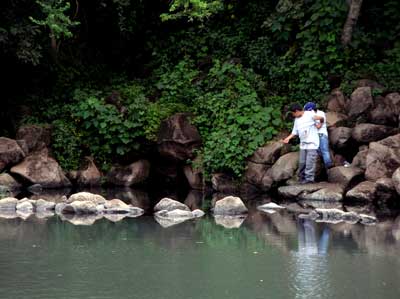 |
Sure enough, Ameca splendens was there in abundance, busily nibbling at the
algae on the rocky bottom. I could see why this fish loves algae, as thermal
springs are common all around this area and where there’s hot or warm water,
there are always algae.
Enrique Meza agreed it would be easy to build a retaining wall around this
spring to raise its water level above the river’s, thus keeping out pollution
and, perhaps, the ubiquitous tilapia which have been introduced into every body
of water we know of in Mexico.
THE AMECA PROJECT: RED
TAPE
Next followed many discussions among the Mexican fish experts. We learned that
Mexican environmental laws require an impact study before any sort of
animal-protection project can be started. Our resident fish expert, José Luis
Zavala began said impact study, but was stricken by personal tragedy and no
longer able to give the project the time it needed.
The months rolled by with no progress. It looked like Ameca s. could go extinct
while all the legal niceties were being attended to. Ivan was devastated.
“Please,” he wrote, “is there any reason why we can't press ahead with the
setting up of the new Ameca reserve by undertaking stage one? That’s the
isolation and building up of just the spring only. I have found funding for
this...”
|
...It occurred to us that the Teuchitlán municipality had succeeded in building a
walkway and had put up bridges and benches without any great difficulty. Would
they be willing to just go ahead and build the little retaining wall, which,
after all, had been suggested by the Municipal President himself? Well, we
phoned up Enrique Meza and he said, “Sure, why not?” So we asked for an estimate
and—and suddenly Ivan was gone.
A caballero on one of the
locally built bridges across the river
|
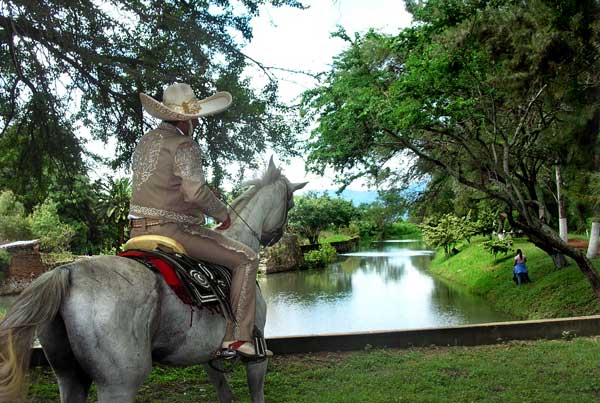 |
There you have it, the story of The Ameca Project from the beginning to where we
now stand—not, I hope, the end, but at a point where we need to make an extra
effort to carry on where a mightily determined man named Ivan Dibble has pointed
the way.
John Pint
Guadalajara, Mexico
January 5, 2010
Donations
If you would like to assist or donate to the Ameca Project, contact the Pints (Ranchopint@hotmail.com).
To donate to Fish Ark Mexico, contact Don Kenwood (donkenwood@blueyonder.co.uk)
.
 Ameca splendens is the name of a little fish with a bright yellow vertical
stripe on the male’s tail, popular among aquarium owners all around the world.
It is found in the Teuchitlán River, not far from the famous “circular pyramids”
of Teuchitlán in the West Mexico state of Jalisco. Ameca s. gives birth to its
babies live, loves to eat algae and quickly became popular among fish fanciers
when Ivan Dibble of the British Livebearer Association brought the fish to
England and began raising and distributing it to his fellow hobbyists.
Ameca splendens is the name of a little fish with a bright yellow vertical
stripe on the male’s tail, popular among aquarium owners all around the world.
It is found in the Teuchitlán River, not far from the famous “circular pyramids”
of Teuchitlán in the West Mexico state of Jalisco. Ameca s. gives birth to its
babies live, loves to eat algae and quickly became popular among fish fanciers
when Ivan Dibble of the British Livebearer Association brought the fish to
England and began raising and distributing it to his fellow hobbyists.



